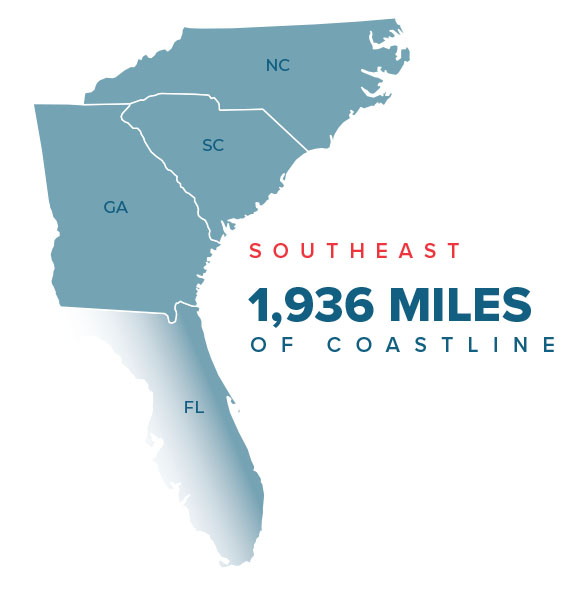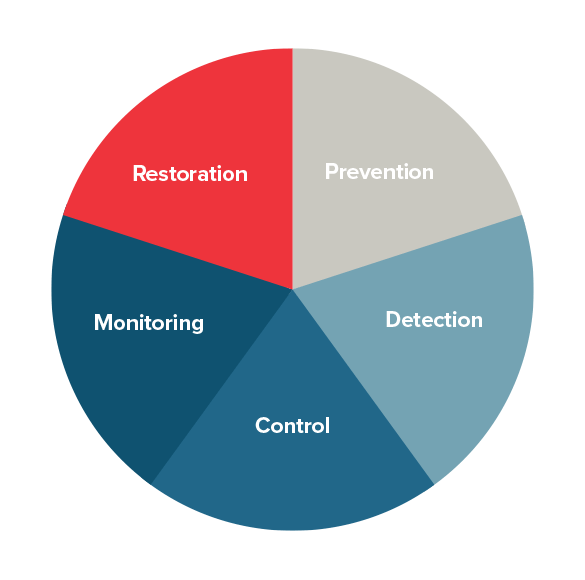Southeast Project Resources:

“From the mountains to the coast, the southeastern U.S. contains ecosystems that harbor incredible biodiversity. Many of those ecosystems are already highly at risk from urbanization and other human land-use change.”
–Jennifer Constanza, U.S. Geological Survey
The Southeast region includes the states of North Carolina, South Carolina, Georgia, and eastern Florida. With nearly 2,000 miles of Atlantic shoreline, the majority of the region has a humid subtropical climate. Winters are mild, while the remaining seasons have warm to hot weather with average to above average rainfall.
The Southeast region is largely part of the North American Coastal Plain, which was recently identified as the world’s 36th biodiversity hotspot. The North American Coastal Plain has suffered greater than 70% habitat loss.
Invasive species cause ecological harm by displacing native species, degrading habitat, and altering food webs. This, in turn, can negatively impact industries such as fishing, agricultural, and tourism and can threaten human health.
Aquatic invasive species can harm local water supplies, damage native ecosystems, impact outdoor recreation activities, and threaten our health and safety. They cost the U.S. billions of dollars annually to manage and can cause long-term economic and environmental harm.

Common invasive species in the Southeast
Some of the common invasive coastal plant species include: Phragmites (common reed), kudzu, Japanese knotweed, Hydrilla, water hyacinth, giant salvinia, mile-a-minute, stiltgrass, autumn olive, milfoil, yellow-flag iris, Chinese privet, honeysuckle, and alligator weed.
Invasive species and noxious weed classifications are very regionally specific. Sometimes, a plant classified as invasive in one area may not be invasive in another. Check the local noxious weed lists for species considered invasive and what level of control is required. Treatment/removal is unique to the plant species. Some species are easy to remove with hand-pulling. Some species infestations are made worse by hand-pulling and must be controlled with pesticides in accordance with a permit. Consultation with local invasive species authorities is necessary when working with invasive species.


The best way for you to help prevent the spread of invasive plant species is to stop new outbreaks before they start. Each of us has a role in keeping our waterways clean and healthy for future generations. For example, the best way that you can help to prevent the spread of aquatic invasive species is to always clean your boat after use.
Early detection can help avoid many of the environmental and economic losses caused by invasive species. Reporting invasive species to the experts could stop the next invasion.
Report invasive species through the national Early Detection and Distribution Mapping System (EDDMapS).
Additionally, many states have invasive species reporting hotlines, online forms, or mobile apps. Using your internet browser, search with the terms “invasive species reporting [enter your state or county]” to discover how best to report in your area.

While invasive species pose major challenges, a number of management options exist. Prevention is important, but that is beyond the scope of this website. Physical or mechanical control, chemical control, cultural management, and biological control are all useful tools.
Removing invasive species and restoring native species brings myriad benefits. Restoration of wetlands, dunes, and other coastal areas protects against erosion, reduces flooding, and improves water quality. Native birds, fish, and other wildlife return to restored areas, enhancing fisheries and biodiversity. Habitat improvement helps the recovery of threatened or endangered species. Tourism and outdoor recreation benefit as people fish, bird watch, or visit wildlife areas.
What can you expect if you want to remove invasive species?
Invasive species removal can be a rewarding activity for any group of concerned citizens. Many species can be removed by hand, with little training. It is best to consult a local expert to understand the likely long-term outcomes of your effort. Some plant species can only be substantially reduced using fire, changing land elevation, or applying herbicides across large areas, in accordance with permits. Some plant infestations are made worse by hand-pulling, which can break the material into many pieces, each of which can sprout a new plant (e.g. knotweed) and can only be reduced with pesticides (permit required).

Prevention, detection, control, monitoring and restoration are all important objectives of invasive weed management programs. Source: https://www.fs.usda.gov
We need your help to improve the Toolkit by completing our easy, 3-minute survey. Your insight is valuable to us.